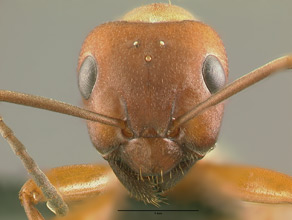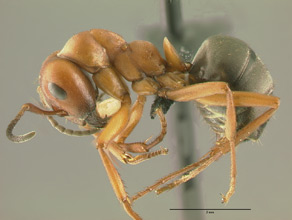- Identification
- Medium-sized bicolored workers (darker brown gaster with lighter colored, reddish-yellow alitrunk and head) with dense gastric pubescence. Formica aserva belongs to the sanguinea species group. The group is behaviorally differentiated from other Formica by their slavemaking habitats. Morphologically their dense gastric pubescence and an indentation in the middle of the clypeus or, more technically, a median concave impression on the anterior border of the clypeus set them apart from other North American Formica.
- Biology
- A facultative slavemaking ant that exploit and parasitize other Formica species. Wide ranging and exhibiting large variation in its nesting and habitat preferences. Creighton (1950) notes:
The nesting habits ... are extraordinarily flexible..... The nests may be constructed in heavy woods (either deciduous or coniferous), in open woods or in fully exposed areas. They may be built in open soil, in and under rotten stumps and logs or beneath stones. The nests are often banked with thatching, but this is not invariably the case.... is an aggressive and active ant and often changes its nest.
- additional biology notes...
- Distribution
- Range
- Canada and United States. Alaska to Newfoundland, southeast into New England and south through the Appalachians, southwest throughout mountainous regions to New Mexico and Arizona.
- Navajo Reservation Records
- Sample records being processed.
- Additional Notes
- In a study from Elk Island National Park, Alberta Province (Savolainen and Deslippe, 1996), a third of the Formica aserva colonies had slaves. When present, foreign workers made up an average of 10% of the workforce. Enslaved individuals, based on their size, were believed to be obtained primarily from incipient nests.
- The sanguinea species group are ants that parasitize and enslave other Formica species. Most of the species are believed to be facultative and not obligate slave makers. The raiding ants often restrict their attention to specific Formica subgroups (e.g. the fusca, neoformica or neogagates species group) but, at least for wider ranging forms, do not appear to specialize on any single Formica species. All the sanguinea species are dependent upon parasitizing a foreign host species for starting new nests; newly mated queens must enter the nest of another Formica species, kill the queen, and be adopted by the workers in order to succeed in founding a new nest.
- Slave raiding is a highly coordinated set of behaviors carried out in a stereotypical manner (as explained in this account of Formica gynocrates nest raids): a raiding party is initiated after a scout successfully locates and reports back to their colony that there is a raidable nest, workers swarm to and enter the target nest, larvae and pupae are stolen from the raided colony, and the captured individuals are brought back to the raider's nest. Most of the larvae are used for food but some pupae are are allowed to eclose in what is, to them, a foreign colony. Ants that eclose within a foreign nest subsequently behave as if the colony is their own natal nest. The enslaved workers thus care for the brood of their host, maintain the nest, forage and even participate in future raids.
- Taxonomic Note
- The name Formica subnuda is a synonym of Formica aserva.
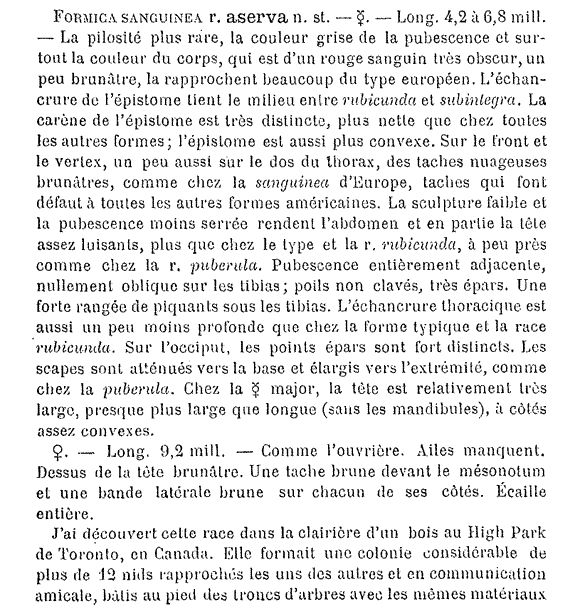
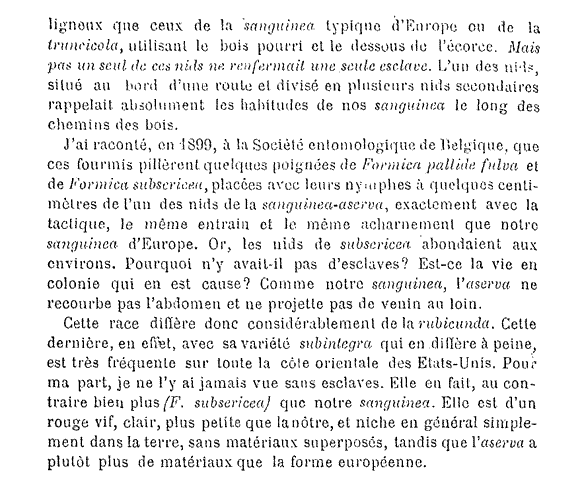

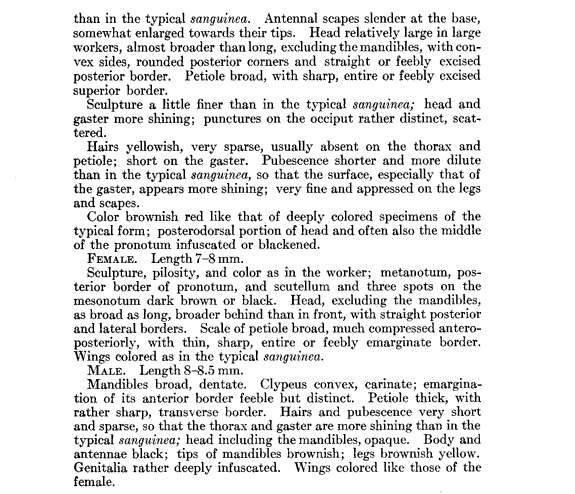
- Literature
- Creighton, W. S. 1950. The ants of North America. Bulletin of the Museum of Comparative Zoology at Harvard University. 104:1-585.
- Forel, A. 1901. Fourmis termitophages, Lestobiose, Atta tardigrada, sous-genres d'Euponera. Annales de la Société Entomologique de Belgique. 45:389-398. PDF
- Savolainen, R. and R. J. Deslippe. 1996. Facultative and obligate slavery in formicine ants: frequency of slavery, and proportion and size of slaves. Biological Journal of the Linnean Society. 57:47-58.
- Wheeler, W. M. 1913. A revision of the ants of the genus Formica (Linné) Mayr. Bulletin of the Museum of Comparative Zoology at Harvard University. 53:379-565.
- A note about these publications. The literature cited here is not meant to be an exhaustive list of papers published about this species.
Page authored by David Lubertazzi and Gary Alpert
